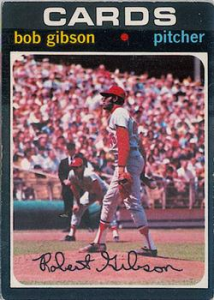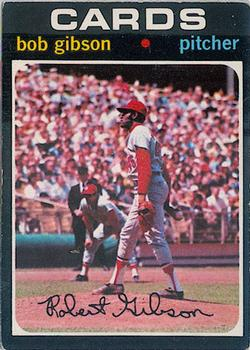May 23, 1970: Bob Gibson fans 16 in Hall of Fame matchup with Jim Bunning
 When would-be saboteurs tried to pull distractions on Bob Gibson, it never seemed to diminish his work. Rather, it merely poked the bear.
When would-be saboteurs tried to pull distractions on Bob Gibson, it never seemed to diminish his work. Rather, it merely poked the bear.
Before pitching the seventh game of the 1967 World Series in Boston, Gibson was disturbed in his hotel room three times in the middle of the night by “mistaken” wake-up calls. And when he sat down to his breakfast at the hotel’s coffee shop in the morning, he was given burnt toast by his server – twice.
Therefore, in early hours of May 23, 1970, it was little wonder to the star pitcher that the fire alarm in the Sheraton Hotel in Philadelphia had been pulled at 6 o’clock in the morning – as Gibson and his St. Louis Cardinals were slated to face the Phillies that night in Connie Mack Stadium.1 Rubbing his sleepy eyes inside another room down the hall was Dick Allen, the former Phillies slugger who had spent the past seven seasons in the City of Brotherly Love but was now returning to town as a Cardinal after being part of a multiplayer trade.
To Gibson’s surprise, the alarm turned out to be legitimate. A fire had broken out on the 15th floor of the hotel, with the Cardinals staying on the 19th and 20th floors as Jose Cardenal, Mike Shannon, and Julian Javier banged on doors to wake the inhabitants – but only after Javier struggled to locate his eyeglasses.2 The groggy Cardinals (19-18, in second place in the National League’s Eastern Division and winners of nine of their last 13) readied themselves for manager Frank Lucchesi’s struggling Phillies (15-24, in last place in the East and losers of 12 of their last 14).
The tempestuous Allen had been acquired after the 1969 season in a trade involving seven players, including longtime St. Louis catcher Tim McCarver. McCarver had been a mainstay behind the plate for the Cardinals’ three pennant-winning teams in the 1960s but would not be facing his old batterymate in Gibson on this particular evening, as he had broken his hand on May 2 and was lost to the Phillies for the next four months. Also shipped out of St. Louis in the transaction was outfielder Curt Flood, who refused to report to Philadelphia when the deal was announced.
Gibson, holding a 19-6 career record against the Phillies entering the game, was set to square off against fellow living legend Jim Bunning, who was 5-9 lifetime against the Cardinals. The two future Hall of Famers had seen better days; Gibson was 2-3, not having won since April 26 and being pounded by the Astros and Pirates in his last two starts with his ERA ballooning to 5.34. Bunning, meanwhile, was 1-5, having suffered from poor run support, evidenced by his 2.45 ERA.
Absent from the leadoff slot for the Cardinals was their customary figure. Yet another future inductee to Cooperstown, Lou Brock, had been out of the St. Louis lineup since he fouled a ball off his instep during batting practice five days before in Houston’s Astrodome. “Brock, who has been wearing a sandal on his right foot, was ready to pinch-hit, manager Red Schoendienst said,” wrote Neal Russo in the St. Louis Post-Dispatch.3
In Brock’s stead was Cardenal, gazing out at the 13-year veteran Bunning, who entered the night with 2,689 career strikeouts –behind only Walter Johnson’s distant total of 3,509. The game started an hour and 18 minutes late because of a lingering rainstorm as a sparse crowd of just over 12,000 fans looked on.
After retiring Cardenal on a groundout to rookie shortstop Larry Bowa and striking out Leron Lee for number 2,690, Bunning faced off against Allen. Challenging for the National League lead in hitting at .312, Allen was greeted with “far more boos than cheers,” noted Russo.4 A derisive banner hanging from the ballpark’s left-field pavilion read, “How Do You Like Your New Babysitter, Richie?” – invoking a variation of Allen’s first name that he did not appreciate.5
Waving his big club at Bunning, Allen had already left his mark against his former teammates in 1970, having homered three times against the Phillies – once in the series opener on May 21 off Woodie Fryman, once back in St. Louis off Bunning on May 11 (providing all three runs in a 3-0 Cardinals triumph), and the following night off Lowell Palmer as well.
On a 1-and-2 count, Allen caught hold of a Bunning curveball and sent a drive into the left-center-field gap. At the last second, center fielder Oscar Gamble swooped in and snared the ball.
When it was Gibson’s turn to go to work in the bottom of the first, he looked over at first base and saw Allen back at his preferred position. Only in the past week had Dick returned there, having been forced to patrol third base since the start of the season with Shannon’s absence due to his frightening battle with nephritis.
After Bunning escaped unharmed in the second when the Cardinals loaded the bases with nobody out, Allen returned for his second chance in the top of third. Stepping into the box with two down, he saw Lee on second base. Lee had singled and stolen second off rookie catcher Mike Compton (during the pregame rain delay, Lee had borrowed Allen’s jersey, wrapped a towel around his head, and headed to the Phillies’ dugout to say hello – a move that fooled the fans who were watching, but not his former teammates).
On a 2-and-2 count, Allen drove a long home run over the center-field wall to give the Cardinals a 2-0 advantage, “a titanic drive, well beyond the 410-foot marker,” marveled Russo.6
Gibson, meanwhile, retired the first 10 Phillies he faced, seven on strikeouts. Denny Doyle broke the string with one out in the fourth inning by pushing a single to left field, snapping a personal 0-for-18 stretch. He was quickly erased, however, as Gamble grounded into a double play to Dal Maxvill at short to keep Gibson at the minimum faced.
Allen appeared again in the fifth with two out. He hooked a Bunning pitch just foul to the upper deck, making the count 1-and-2. On the next offering – a curveball low and away – he was able to keep the ball fair this time with “a drive that hit the sign on the roof in left field.” Allen was actually fooled on the pitch, but simply “flicked his wrists” and his massive strength sent the sphere off the premises.7 It was his 16th homer of the season, tying him for the major-league lead with Hank Aaron. “It was difficult to tell which balls were traveling faster – the ones Allen hit or the ones Gibson threw,” Philadelphia Inquirer writer Allen Lewis concluded at that point.8
The minimum for Gibson continued through the Philadelphia fifth and sixth, as six more went down in order. Among them were four more strikeouts, bringing Gibson’s total to 11, But Bunning, the fireballer from northern Kentucky, was nearly as good, fanning his counterpart Gibson to start the seventh and getting Cardenal looking on strikes as well. (Cardenal, ejected from the previous night’s game for arguing a called third strike, had to then be restrained from home-plate umpire Ken Burkhart.)
Scoring against Gibson appeared hopeless until Larry Hisle walked to lead off the Phillies’ eighth and was tripled home by Ron Stone. But Gibson righted himself, striking out Byron Browne in the ninth to end the game for a 3-1 Cardinals win in a mere 2 hours and 8 minutes.
Gibson’s 16 strikeouts matched teammate Steve Carlton’s total posted two nights earlier in Connie Mack Stadium and were his regular-season career high, topped only by his famous Game One performance (17 K’s) in the 1968 World Series against the Detroit Tigers. “That was the hardest I’ve thrown since ’68,” Gibson affirmed. “Tonight I had something extra. And I got just about every pitch where I wanted.”9 It was Gibson’s final appearance in Connie Mack Stadium with the opening of Veterans Memorial Stadium in the south end of town the following spring.
As for Bunning, his career would slightly outlast the old yard. After joining Cy Young in August 1970 as the only pitchers to record at least 100 victories in each league, Bunning returned to the Phillies for one final season in 1971 and won the first game in their shining new facility.
Allen, meanwhile, seemed to show little sentimentality for Philadelphia. “I just want to hit one more [homer in the series finale the next day] and get out of here,” he said after the game.10
As the Cardinals headed to New York for the next leg of their road trip, Flood, their former All-Star center fielder, would be there as well – appearing as the plaintiff in his lawsuit against Major League Baseball’s reserve clause at the courthouse in Manhattan.
In a gesture of friendship, Gibson left tickets for Flood at Shea Stadium should he wish to attend.11
SOURCES
In addition to the sources listed in the Notes, the author consulted Baseball-Reference.com, Retrosheet.org, and SABR.org.
NOTES
1 Neal Russo, “Tired Hoolie Gets Four RBIs,” St. Louis Post-Dispatch, May 23, 1970: 5A.
2 Doug Feldmann, Gibson’s Last Stand: The Rise, Fall, and Near-Misses of the St. Louis Cardinals, 1969-1975, 70. (Columbia: University of Missouri Press, 2013).
3 Neal Russo, “Gibson and Allen Overcome Phillies, 3-1,” St. Louis Post-Dispatch, May 24, 1970: 1E.
4 Russo.
5 Feldmann, 70.
6 Russo.
7 Russo, 4E.
8 Allen Lewis, “Allen’s 2 Homers Rock Phils, 3-1,” Philadelphia Inquirer, May 24, 1970: 16.
9 Lewis.
10 Lewis.
11 Feldmann, 71.
Additional Stats
St. Louis Cardinals 3
Philadelphia Phillies 1
Connie Mack Stadium
Philadelphia, PA
Box Score + PBP:
Corrections? Additions?
If you can help us improve this game story, contact us.


